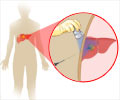Proactive outreach to cirrhosis patients in a safety net health system successfully doubled their screening rates for liver cancer, revealed researchers.

‘A proactive, population health outreach strategy can improve liver cancer screening and early detection among cirrhosis patients.’





"Finding ways to reach patients at high risk of liver cancer is
critical. Liver cancer has the fastest increasing mortality rate among
solid tumors in the U.S.," said first author Dr. Amit G. Singal, Associate Professor of Internal Medicine and Clinical Sciences, and a member of the Harold C. Simmons Comprehensive Cancer Center. "This high mortality is primarily due to low rates of liver cancer screening and high rates of late-stage diagnosis."
The study randomly divided 1,800 cirrhosis patients at Parkland Health & Hospital System in Dallas into three groups. The first group received mailed outreach invitations for screening ultrasound. The second group received similar outreach plus patient navigation, and the third received their usual care. Researchers learned that the group receiving mailed outreach invitations were most likely to schedule an ultrasound, which doubled the overall rate of screening.
The study appears in the journal Gastroenterology.
"Our study is one of the first interventions to improve liver cancer screening and early detection among at-risk patients. The vulnerable patient population we studied in our safety net health system are those who are at highest risk of dying from liver cancer, so this intervention helped those who might benefit the most," said Dr. Singal.
Only one-fourth of patients with cirrhosis in routine care are currently screened every six months for liver cancer with an ultrasound as recommended by national guidelines. Symptoms are not usually present when the cancer is in its early stages.
Advertisement
According to the National Cancer Institute, liver cancer is diagnosed in an estimated 39,230 people annually. In 2013, there were an estimated 54,954 people living with this cancer in the U.S. Risk factors include a diagnosis of fatty liver disease, hepatitis B, hepatitis C, cirrhosis, or a combination of these diseases.
Advertisement















